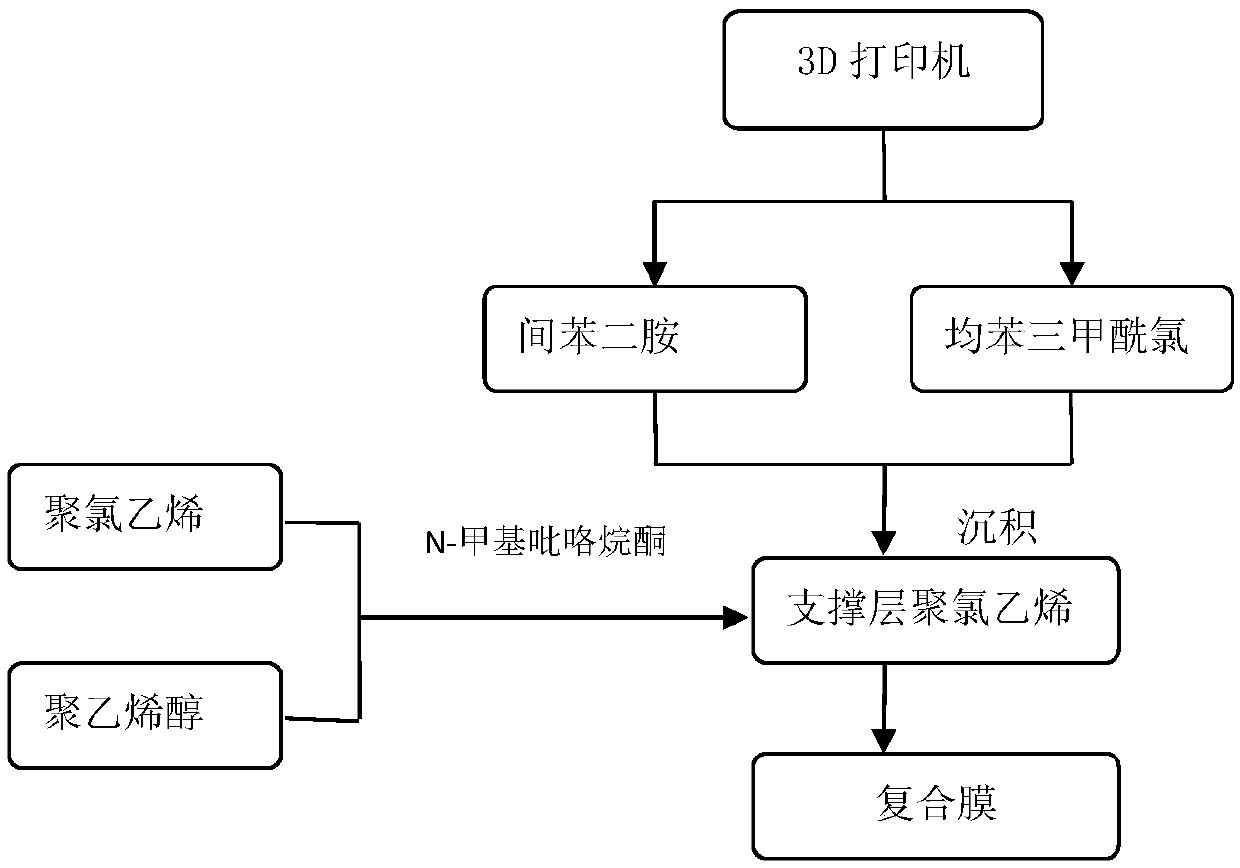Preparation method of forward osmosis membrane based on 3D printing technology
A technology of forward osmosis membrane and 3D printing, which is applied in the field of membrane technology and water treatment, can solve the problems of expensive raw materials, low cost performance and low feasibility, and achieve the effect of low price, stable raw materials and stable performance
- Summary
- Abstract
- Description
- Claims
- Application Information
AI Technical Summary
Problems solved by technology
Method used
Image
Examples
preparation example Construction
[0023] Such as figure 1 The method for preparing a forward osmosis membrane based on 3D printing technology proposed by the present invention includes the following steps:
[0024] (1) Preparation of polyvinyl chloride support layer, the specific process is:
[0025] (1a) Add polyvinyl alcohol and polyvinyl chloride with a mass ratio of 0.005g:1g~0.11g:1g to N-methylpyrrolidone, stir in a round-bottomed flask until polyvinyl alcohol, polyvinyl chloride and N-methyl Pyrrolidone is completely dissolved to form a uniform and stable solution, and the solid-to-liquid ratio of polyvinyl chloride to N-methylpyrrolidone is 0.16g:1mL~0.20g:1mL;
[0026] (1b) Place the above-mentioned uniform and stable solution at a temperature of 23~25℃ for deaeration, then transfer the solution to an automatic film coating machine to form a uniform film to obtain a polyvinyl chloride support layer, and store it in deionized water for later use;
[0027] (2) Preparation of composite membrane, the specific p...
Embodiment 1
[0032] To prepare a forward osmosis membrane based on 3D printing technology, the specific process is as follows:
[0033] (1) Preparation of polyvinyl chloride support layer, the specific process is:
[0034] (1a) Take 1g of polyvinyl chloride, add polyvinyl alcohol with a mass ratio of 0.005g:1g to polyvinyl chloride into N-methylpyrrolidone, and stir in a round bottom flask until polyvinyl alcohol, polyvinyl chloride and N— Methylpyrrolidone is completely dissolved to form a uniform and stable solution, and the solid-to-liquid ratio of polyvinyl chloride to N-methylpyrrolidone is 0.16g:1mL;
[0035] (1b) Place the above uniform and stable solution at room temperature 23°C and let it stand for deaeration, and then transfer the solution to an automatic film coating machine to form a uniform film to obtain a polyvinyl chloride support layer, and store it in deionized water for later use;
[0036] (2) Preparation of composite membrane, the specific process is:
[0037] (2a) Add m-phenyl...
Embodiment 2
[0044] To prepare a forward osmosis membrane based on 3D printing technology, the specific process is as follows:
[0045] (1) Preparation of polyvinyl chloride support layer, the specific process is:
[0046] (1a) Take 1g of polyvinyl chloride, add polyvinyl alcohol with a mass ratio of 0.058g:1g to polyvinyl chloride into N-methylpyrrolidone, and stir in a round bottom flask until polyvinyl alcohol, polyvinyl chloride and N- Methylpyrrolidone is completely dissolved to form a uniform and stable solution, and the solid-to-liquid ratio of polyvinyl chloride to N-methylpyrrolidone is 0.18g:1mL;
[0047] (1b) Place the above uniform and stable solution at room temperature 24°C and let it stand for deaeration, then transfer the solution to an automatic film coating machine to form a uniform film to obtain a polyvinyl chloride support layer, and store it in deionized water for later use;
[0048] (2) Preparation of composite membrane, the specific process is:
[0049] (2a) Add m-phenylened...
PUM
| Property | Measurement | Unit |
|---|---|---|
| Aperture | aaaaa | aaaaa |
| Thickness | aaaaa | aaaaa |
| Diameter | aaaaa | aaaaa |
Abstract
Description
Claims
Application Information
 Login to View More
Login to View More - R&D
- Intellectual Property
- Life Sciences
- Materials
- Tech Scout
- Unparalleled Data Quality
- Higher Quality Content
- 60% Fewer Hallucinations
Browse by: Latest US Patents, China's latest patents, Technical Efficacy Thesaurus, Application Domain, Technology Topic, Popular Technical Reports.
© 2025 PatSnap. All rights reserved.Legal|Privacy policy|Modern Slavery Act Transparency Statement|Sitemap|About US| Contact US: help@patsnap.com

